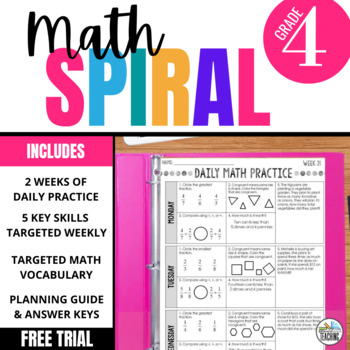4th Grade Math Spiral Review: Free Daily Practice Activities or Homework
- PDF
- Google Apps™

Description
This free trial of my 4th grade spiral review bundle has both printable & digital options and is perfect for offering short, consistent practice opportunities and helping students build the confidence they need to be successful on state assessments and in middle school math.
There are so many math standards to cover in fourth grade. Math spiral review has been shown to be an effective way to help students get the practice they need to master these skills.
Designed to take less than 15 minutes per day - including giving students time to complete, discuss, and review, this spiral math is low prep and easy to implement.
Each week's work focuses on building mastery toward 5 critical math skills. You can use Friday as an assessment, and the student answer sheet offers space for guided support and corrections.
This product is a free sample from my 4th Grade Math Spiral Review: Print & Digital Daily Warm-ups or Homework.
Your free trial includes:
- 4 weeks of standards-aligned spiraled math practice (Print & Google Slides)
- Scope & sequence
- Weekly student objectives with aligned math vocabulary
- Answer keys
Math Skills & Topics Covered:
✔ Multi-step problem solving
✔ Computation with positive and negative integers, fractions, and decimals
✔ Algebraic expressions
✔ Data Analysis
✔ Area & Volume (including surface area)
and more!
Way to Use this Math Spiral Review
• Digital classrooms or for home learning
• Interactive whiteboard or projector during whole or small group math instruction
• Projected as a warm-up or bellringer
• Test prep
• Homework
Benefits of the Math Spiral Review Format:
❑ Daily practice builds routine and structure for practice
❑ Less overwhelming to reluctant or struggling learners
❑ Helps identify students who may need additional support
❑ Encourages discussion about skills & strategies
******************************************************************
Terms of Use:
© 2018 Rebecca Davies. All rights reserved by author. These materials are intended for personal use by a single classroom only. Copying for more than one teacher, classroom, department, school, or school system is prohibited. For use in multiple classrooms, please purchase additional licenses. This product may not be distributed or displayed digitally for public view. Failure to comply is a copyright infringement and a violation of the Digital Millennium Copyright Act (DMCA). Clipart and elements found in this PDF are copyrighted and cannot be extracted and used outside of this file without permission or license. See product file for clip art and font credits.
Questions?
Click here to contact me directly via email.





